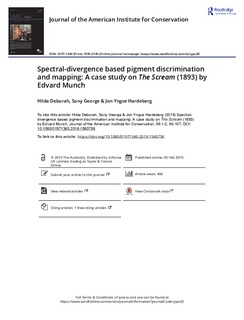| dc.contributor.author | Deborah, Hilda | |
| dc.contributor.author | George, Sony | |
| dc.contributor.author | Hardeberg, Jon Yngve | |
| dc.date.accessioned | 2019-10-31T12:01:07Z | |
| dc.date.available | 2019-10-31T12:01:07Z | |
| dc.date.created | 2019-04-16T16:12:34Z | |
| dc.date.issued | 2019 | |
| dc.identifier.citation | Journal of the American Institute for Conservation. 2019, 58 (1-2), 90-107. | nb_NO |
| dc.identifier.issn | 0197-1360 | |
| dc.identifier.uri | http://hdl.handle.net/11250/2625586 | |
| dc.description.abstract | An important application of imaging spectroscopy or hyperspectral imaging is the classification or discrimination of pigments based on the obtained spectral reflectance information. As opposed to being a point-analysis tool, this non-invasive method captures the entire surface of interest. This means that its potential is not only in the discrimination of pigments but also in their mapping. However, the challenge lies in the fact that in a real painting, there is no clear-cut edge between regions with certain pure pigments or of the exact same mixture. Pigments and other paint materials mix seamlessly and continuously in the physical domain. In this article, we introduce a divergence-based approach to pigment discrimination and mapping. The methodology is then applied to Munch’s masterpiece The Scream (1893), whose pigments and materials have been identified for several points in the painting in a previous study. Through the introduced methodology, we have been able to extend the point analyzes of pigments and materials to the entire surface of the painting, recto and verso. | nb_NO |
| dc.language.iso | eng | nb_NO |
| dc.publisher | Taylor & Francis | nb_NO |
| dc.rights | Attribution-NonCommercial-NoDerivatives 4.0 Internasjonal | * |
| dc.rights.uri | http://creativecommons.org/licenses/by-nc-nd/4.0/deed.no | * |
| dc.title | Spectral-divergence based pigment discrimination and mapping: A case study on The Scream (1893) by Edvard Munch | nb_NO |
| dc.type | Journal article | nb_NO |
| dc.type | Peer reviewed | nb_NO |
| dc.description.version | publishedVersion | nb_NO |
| dc.source.pagenumber | 90-107 | nb_NO |
| dc.source.volume | 58 | nb_NO |
| dc.source.journal | Journal of the American Institute for Conservation | nb_NO |
| dc.source.issue | 1-2 | nb_NO |
| dc.identifier.doi | 10.1080/01971360.2018.1560756 | |
| dc.identifier.cristin | 1692971 | |
| dc.description.localcode | © 2019 The Author(s). Published by Informa UK Limited, trading as Taylor & Francis Group This is an Open Access article distributed under the terms of the Creative Commons Attribution-NonCommercial-NoDerivatives License (http://creativecommons.org/licenses/by-nc-nd/4.0/), which permits non-commercial re-use, distribution, and reproduction in any medium, provided the original work is properly cited, and is not altered, transformed, or built upon in any way. | nb_NO |
| cristin.unitcode | 194,63,10,0 | |
| cristin.unitname | Institutt for datateknologi og informatikk | |
| cristin.ispublished | true | |
| cristin.fulltext | postprint | |
| cristin.qualitycode | 2 | |

